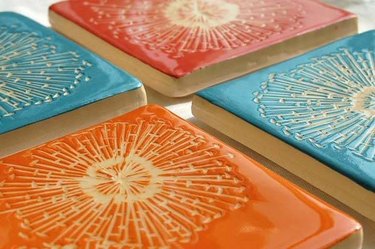Things You'll Need
Sculpting clay
Drying board (can be plywood or a cutting board)
Clay roller
Clay cutter
8-inch square wood block
Tile setter or kiln
Wire racks or sheets of drywall
Silica sand
Epoxy or oil-based paint and brushes
Water-based urethane

Making your own decorative ceramic tiles may seem complicated, but it is quite the opposite. With a little work and patience, you can make your own personalized tiles for less than half of the cost of purchasing them. Materials are inexpensive and if you live in an area that has clay-based soil, you can even use your own clay. These tiles can then be used to create backsplashes, countertops, or for any other decorative application.
Step 1
Choose the right type of clay. You want a clay that has a high amount of grog, such as Raku or any clay designed for sculpting. Grog is clay that has already been fired and ground down into small particles. Then, it is added to wet clay. Grog helps give the wet clay more stability and makes it more dense than clay without grog. You also want your clay to have a low absorption rate. Look at the package. It should say that the absorption rate after firing is 3 percent or less.
Video of the Day
Step 2
Roll your clay out onto the board where it will dry. Use a roller made for rolling clay, such as the Brent or North Star roller. You do not want to have to move the slab later, as this may cause it to warp. The clay should be rather dry. The thickness of the clay should be around 1/2 inch for an 8-inch square tile, which is the standard size of most handmade tiles. Roll it out, flip it over, and roll it out again.
Step 3
Let the clay dry until it is the texture of leather. Make an 8-inch square template of wood. Cut out your tiles. If you are going to create a design on the tiles, do it before you cut it. If you cut the square first, the action of pressing the design into the tile will deform the square.
Step 4
Dry and fire the tiles. You can dry tiles in one of two ways. First, you can place the tiles between sheets of drywall. The drywall will wick the moisture out of the clay evenly on both sides of the tile. Alternately, you can dry the tiles on racks. Just make sure both the bottom and top of the tile are drying evenly. Then, fire the tiles. You can fire them in a tile setter or in a kiln shelf that has been lightly dusted with some silica sand.
Step 5
Paint the tiles. Use oil or epoxy paints, with a high or semi-gloss. You can paint them all one color or paint a design on them. Once painted, let them dry for at least two days; then, cover them with a coat of water-based urethane, not oil-based.
Tip
Cut grooves into the backs of the tiles for better adhesion. One way to do this is to roll the clay out onto grooved cardboard.
Warning
If you are going to place the tiles in a high-humidity area, such as a shower stall, it is best not to paint them. Instead, consider etching them with a decorative design instead.
Video of the Day